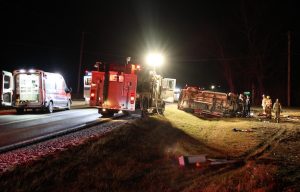Lepp looks back on WWII

This coming Tuesday, neighboring towns will join thousands of other communities across the United States in celebrating the individuals who have fought this country’s battles throughout its history.
Monroe County is home to many such veterans, including one who recently sat down to speak about his experience joining the tail end of World War II.
Charlie Lepp was born and raised in Columbia in 1926. At 99 years old, he’s set to celebrate his centennial this coming March.
He recalled attending Catholic grade school before moving on to high school in East St. Louis – though he left school after two years to work, later getting his diploma after leaving the service.
Work had him at a quarry during the war, though he later found himself working for Monsanto.
Lepp recounted his military tenure, which had him doing a great deal of traveling throughout the U.S. before he ultimately wound up in the Pacific.
He recalled being drafted in the spring, just a month or two after his 18th birthday. Along with other recruits, he wound up on a bus to East St. Louis before taking a train up to Fort Sheridan in Chicago.
Wishing to join the Navy, he was turned away and instead drafted into the Air Corps, the branch of the Army which preceded the modern Air Force.
Basic training for the Air Corps had him travel to Buckley Field near Denver, Colo. He briefly recalled the training, learning how to use his standard rifle.
Additional weapons training took place at Camp Luna, New Mexico, and he began air plane mechanic training at Rosecrans Field near St. Joseph, Mo.
His time at mechanic school was interrupted fairly early on, however.
“The Battle of the Bulge was going on over there in Europe, so everybody was physically fit was put in the infantry, which I was one of them,” Lepp said.
For infantry training, he was sent to Camp Howze in Texas. Furlough sent him home quite briefly, though he soon found himself in Maryland at Fort Meade.
The war in Europe “slacking off,” as he said, Lepp was then thrown right across the country to Fort Ord and then Camp Stoneman in California.
“From there I was shipped out, went South Pacific,” Lepp said. “When we passed the Hawaiian Islands, we zig-zagged every two minutes because of submarines. I was told it took us 35 days to get there, I’m not sure about that.”
He recalled stopping at the Marianas and the Marshall Islands along the way.
Lepp further recalled the cold note on which he and his fellows were sent off.
“We were told this, we most probably wouldn’t come back, and if we did, it wouldn’t be in one piece,” Lepp said. “They said, ‘The gates were open. If you wanted to go AWOL, go,’ but where could you go in San Francisco?”
On the Pacific Front, Lepp’s service took him to the Philippines, specifically the island of Luzon and the capital of Manila.
He spoke about being stationed at Cabanatuan, a Japanese prison camp where American troops had been liberated. Though he saw action during his service, he joined the 43rd infantry division some time after the liberation took place.
Soon after, the U.S. dropped its atomic bombs in Japan, ultimately leading to the Japanese surrender.
Lepp recalled traveling through a typhoon in the Chinese Seas as well as the sight of the harbor in Tokyo around that time, 300-400 American ships amid the remains of the harbor.
“We had to climb off of a rope onto a landing craft,” Lepp said. “I had my M1 rifle, two bandoliers of ammunition, a belt of ammunition and two hand grenades. If I would’ve fell over board, I would’ve been down to the bottom of the water.”
Lepp remained stationed in Japan for a time, staying in Tokyo briefly before spending time in the northern part of Honshu, Japan’s largest island. He then found himself on the southern island of Kyushu.
It was on that north-south trip – and again on his return – that he was able to see the outskirts of Hiroshima after it had been bombed.
“Everything was flat,” Lepp said. “There was maybe a few small buildings left.”
Toward the end of his time in Japan, he returned to the Air Corps. He then returned to the U.S., with time spent in Fort Lawton near Seattle, Wash., before returning to Fort Sheridan and ultimately making his way back home.
While Lepp didn’t recount details of any combat he saw during his service, he was able to look back on his time with some degree of levity.
“I did a lot of traveling, and they paid me for it,” Lepp said.
“But it wasn’t the best accommodations,” his wife Mary added.
Nevertheless, he was pleased to be out of the military, staying out of the reserves and thus being able to avoid further service in the subsequent Korean War.
“Everybody that joined the reserve got put in the Korean War,” Lepp said. “They wanted me to re-sign, but I said no, I had enough.”
Following his military career, Lepp worked a number of jobs through the years, his longest tenure being with American Zinc.
In the decades since, he’s kept close with his fellow veterans as a member of the Columbia American Legion, boasting what is certainly among the longer legion memberships at 80 years.
He also, as his first cousin Mick Steffenauer ribbed him, is exceptionally fond of legion fish fries.
He’s long enjoyed attending legion Veterans Day services, and he recalls being recognized as grand marshal in a past Columbia parade.
Though not as active nowadays, Lepp is still sharp as a tack and has enough energy to keep up with his wife, children, grandchildren and great-grandchildren.
“Wouldn’t be for my wife, I don’t think I’d be here either,” Lepp said. “She’s kept me pretty well straight.”






